A Sail To Southern Ireland
For years I have dreamt of crossing the Celtic Sea to Southern Ireland in the Oyster 42 owned and skippered by a friend. He attempts the crossing almost every year with varying results. Usually the reason for not making it is the sailor’s nightmare – “wind on the nose”. The idea of motoring nearly 200 miles, against the wind, does not appeal. Sometimes the crew have been successful and told me tales of the wonderful scenery, the friendly people, the fantastic restaurants etc. etc. Every time I had tried to join them it was the usual story – “wind from the wrong direction”, “no wind at all”, or “too much wind”. I did get about a quarter of the way there on one attempt, only to turn back and hole up for 4 days in Falmouth while we waited for the gales to blow themselves out.
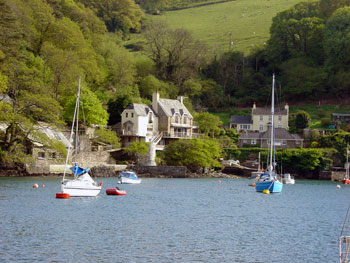 “This will be my last attempt”, I told myself again! So on a very blustery Wednesday afternoon on 10th June 2015 we left Salcombe, in Devon, with 2 reefs in the main sail, for the first short hop to Newton Ferrers, a favourite anchoring of ours. We edged carefully up the River Yealm, the depth showing 0ft, shallower than we’d ever known it. But we made the anchoring safely in time for a good meal ashore.There were six of us aboard, all good friends from previous sailing holidays, but I was the only female. “Do you have to do all the cooking?” some of my friends asked. No way! Most of the jobs are shared out, but I must admit, as I was the least experienced of the crew, by the time I’ve worked out what to do, the task is already done.
“This will be my last attempt”, I told myself again! So on a very blustery Wednesday afternoon on 10th June 2015 we left Salcombe, in Devon, with 2 reefs in the main sail, for the first short hop to Newton Ferrers, a favourite anchoring of ours. We edged carefully up the River Yealm, the depth showing 0ft, shallower than we’d ever known it. But we made the anchoring safely in time for a good meal ashore.There were six of us aboard, all good friends from previous sailing holidays, but I was the only female. “Do you have to do all the cooking?” some of my friends asked. No way! Most of the jobs are shared out, but I must admit, as I was the least experienced of the crew, by the time I’ve worked out what to do, the task is already done.
Typically the weather forecast looked bad and we didn’t fancy the Celtic Sea in the strong winds that were promised, so we had a leisurely sail as far as Fowey, hoping that the forecast would be kinder the following day. Of course the bad weather didn’t materialise. That’s sailing for you! There was very little wind the next day and we ended up motoring most of the way to Penzance, only to find that the expected visitors’ buoys were not in place this year. Our spirits were lifted by a pod of dolphins welcoming us as we anchored in very choppy conditions, outside the harbour and a drop of Glen Morangie, thoughtfully provided by John. It wasn’t the most comfortable night – very rolly, in spite of the home made “flopper stopper”, fashioned by the skipper’s own fair hand.
After an early start to catch the tide we set off towards the Fastnet Rock, hoping for fair winds and calm seas. It’s a long way! My husband Nick kindly volunteered the two of us to do the 2am – 6am watch, appropriately known as the “graveyard watch”. Actually it was better than expected. It was a bit scary coming up on deck to total blackness, seeing that the sails had just been hoisted and being warned of lots of fishing boat hazards. But as we settled into the watch the sky became brighter and I began to feel optimistic that this time I would actually make it. A swallow swooped backwards and forwards many times over the boat. What he was doing so far from land, I’ve no idea. He seemed very tired, as though he wanted a rest on the boat, but he didn’t land. The fin of a Basking Shark was spotted as the faint outline of Ireland came into view.
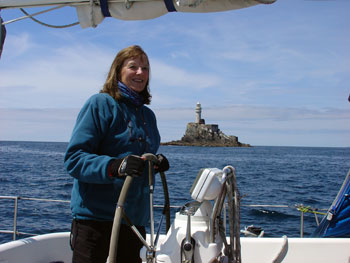 As I was the only member of the crew who had never sailed to Ireland before, I was expected to have the statutory photo chute round the Fastnet Rock, (with me on the helm of course). It only remained to complete the last six miles to Crookhaven, for a well deserved rest. The pretty village lies on a fine natural harbour four miles east of Mizen Head. The extensive lig
As I was the only member of the crew who had never sailed to Ireland before, I was expected to have the statutory photo chute round the Fastnet Rock, (with me on the helm of course). It only remained to complete the last six miles to Crookhaven, for a well deserved rest. The pretty village lies on a fine natural harbour four miles east of Mizen Head. The extensive lig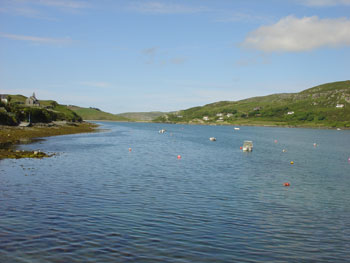 hthouse precincts – now mostly private houses – reflect that this was the shore base from which the Fastnet lighthouse was built and until 1989 it was where the Fastnet keepers’ families lived. In 1920 a Marconi radio station was built, to communicate with the lighthouse and pass messages to and from shipping. So with my feet on Irish soil at last I supped my first ever half of Murphy’s. Well “when in Ireland!”
hthouse precincts – now mostly private houses – reflect that this was the shore base from which the Fastnet lighthouse was built and until 1989 it was where the Fastnet keepers’ families lived. In 1920 a Marconi radio station was built, to communicate with the lighthouse and pass messages to and from shipping. So with my feet on Irish soil at last I supped my first ever half of Murphy’s. Well “when in Ireland!”
After the previous cloud and greyness, Monday dawned fine and sunny, as we sailed westwards along the spectacular coastline towards Dunmanus Bay, the first of the beautiful Rias north of Mizzen Head. This is a quiet, uncrowded sailing area, as most yachts hurry past on their way to the more popular resorts of Bantry Bay. Our destination was Kitchen Cove and the tiny village of Ahakista, where we dropped anchor, took the dinghy ashore and began a lovely walk starting with the beautiful memorial garden to the Air-India disaster. In June 1985 a Boeing 747 flying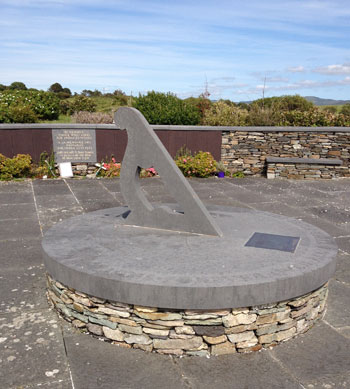 from Montreal to London and Delhi was blow up 180 miles off the Irish coast. The death toll was 329 and it was one of the worst single terrorist incidents until the Twin Towers attack in 2001.
from Montreal to London and Delhi was blow up 180 miles off the Irish coast. The death toll was 329 and it was one of the worst single terrorist incidents until the Twin Towers attack in 2001.
Grey, misty skies greeted us on Tuesday as we retraced our tracks and carried on eastwards towards the small town of Baltimore. As we got nearer, the visibility worsened; very disappointing considering the beautiful scenery we were missing. However a small pod of dolphins came along at just the right moment to cheer us up and we managed, thanks to much moving of dinghies and the help of a lovely, friendly female harbour master (is there such a thing as a “harbour mistress”?), to moor up on a pontoon attached to land; quite a luxury! We found Baltimore a pleasant little town, not pretty, but a real, “lived in” place, where people nevertheless do things in their own time. We and another boat needed fuel so we tracked down Kieron the diesel man. As his bowser had broken down some time ago, he had resorted to bringing down large cans of fuel for the boats and arranged to meet us at 8.45am. By 9am there was no sign of him and we were keen to set off, but we were told, “Sure he’ll be there shortly”. “Shortly”, said the skipper of the other boat, who knew the area well, “is like manyana without the urgency!” Sure enough he arrived sometime after 9.30, filling our tank and then going off to empty and measure what was left in his tank, to work out how much we’d had. Crude – but it worked.
Leaving Baltimore it was still grey and cloudy, but slightly better than when we arrived. The wind gradually got up but didn’t do much to improve the visibility. A potentially nasty incident happened in choppy seas with gusts of force 5. The Genny furling line slipped off the reel while we were gibing and we were forced to hove-to in order to sort it out. This didn’t go down too well with a 2 man racer which we suddenly spotted, bearing down on us. He diverted at the last moment, or was it a lucky miss? We couldn’t believe that he hadn’t seen us and understood that we were helpless to avoid him. They were obviously just focused on the race.
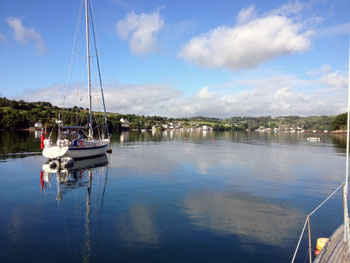 We arrived at Glandore safely; a pretty place in a beautiful bay and opted for a walk ashore with spectacular views over the bay. Returning for a pint of Guinness at the very friendly pub, we learned that Steve and Chris, the skipper and first mate, had spent all their hoped for leisure time doing battle with the domestic water pump which was playing up. Nobly they managed to repair it and still got to the pub in time to join us for a meal and more Guinness.
We arrived at Glandore safely; a pretty place in a beautiful bay and opted for a walk ashore with spectacular views over the bay. Returning for a pint of Guinness at the very friendly pub, we learned that Steve and Chris, the skipper and first mate, had spent all their hoped for leisure time doing battle with the domestic water pump which was playing up. Nobly they managed to repair it and still got to the pub in time to join us for a meal and more Guinness.
With the unfortunate weather delay at the start of the holiday, it was time to start heading back. It seemed a long was to go for just three days in Ireland. This time our route was via the Scillies. Two longish legs suited  me a lot better than one huge one, especially as the Scillies are one of my favourite sailing areas. Lack of wind meant motor sailing for most of the way, but the wind did eventually pick up. Nick and I had the luxury of the sunset and the sunrise watch and we picked up a buoy at New Grimsby, Tresco at 7.50am. A lovely day had dawned and we spent a welcome day ashore with a walk on Tresco in the morning and on Bryher in the afternoon with lunch and dinner at New Inn.
me a lot better than one huge one, especially as the Scillies are one of my favourite sailing areas. Lack of wind meant motor sailing for most of the way, but the wind did eventually pick up. Nick and I had the luxury of the sunset and the sunrise watch and we picked up a buoy at New Grimsby, Tresco at 7.50am. A lovely day had dawned and we spent a welcome day ashore with a walk on Tresco in the morning and on Bryher in the afternoon with lunch and dinner at New Inn.
How can two consecutive days be so different? Setting off at 8.50am with hardly any wind and in the wrong direction, we soon encountered thick fog which would last almost all day. It was strange fog, not very high, so you got the impression that the sun might burn it up and break through, but it never did, and the fog was bright so that we needed sunglasses. It caused some problems as we tried to cross the TSRs and we lost about an hour waiting for six vessels which the radar had spotted, some of whom were on collision courses. We were very thankful for ASI. We didn’t actually see any of these vessels, just heard the fog warning of the Silonion as it went past. Similarly the Lizard was invisible, but we heard the fog warning from the lighthouse. Eventually the fog cleared well NE of Lizard and as the wind got up at last we had a good, if brief, sail into the Helford River.
Returning to Salcombe the following day my feelings were mixed. On the one hand I was delighted that I’d eventually made it to Ireland and was determined to return for a much longer stay, but I don’t think I will be sailing there again. Aeroplane or ferry seems a much more sensible option.
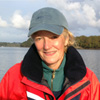
Author - Dee White